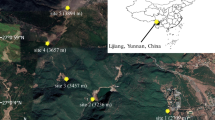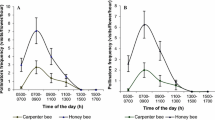Abstract
The rate at which pollen is presented varies widely both among and within species of flowering plants. Although several studies have tried to explain between-species variation in this trait, few explanations exist for the variation that exists among individuals of the same species. I used protandrous fireweed, Chamerion angustifolium (Onagraceae), to examine seasonal changes in pollinator visitation, population sex ratio, and pollen presentation schedules. Most studies that make predictions about optimal pollen presentation assume conditions are constant throughout the flowering season. However, data presented here show that pollen presentation schedules vary seasonally: in early season flowers, anthers dehisce over a number of days, while late season flowers present all anthers simultaneously. I show that pollinator visitation rates to individual plants are higher but more variable early in the season than late in the season. Furthermore, per-male availability of female-phase flowers increases over the course of the flowering season in this population. I suggest that seasonal differences in the variability of pollinator visitation and the availability of female flowers has played an important role in selection for pollen presentation schedules.



Similar content being viewed by others
References
Aizen MA (1997) Influence of local floral density and sex ratio on pollen receipt and seed output: empirical and experimental results in dichogamous Alstroemeria aurea (Alstroemeriaceae). Oecologia 111:404–412
Aizen M A (2001) Flower sex ratio, pollinator abundance, and the seasonal pollination dynamics of a protandrous plant. Ecology 82:127–144
Ashman T-L, Stanton M (1991) Seasonal variation in pollination dynamics of sexually dimorphic Sidalcea oregana ssp. spicata. (Malvaceae). Ecology 72:993–1003
Bertin RI (1993) Incidence of monoecy and dichogamy in relation to self-fertilization in angiosperms. Am J Bot 80:557–560
Bertin RI, Newman CM (1993) Dichogamy in angiosperms. Bot Rev 59:112–152
Brunet J, Charlesworth D (1995) Floral sex allocation in sequentially blooming plants. Evolution 49:70–79
Devlin B, Ellstrand NC (1990) Male and female fertility variation in wild radish, a hermaphrodite. Am Nat 136:87–107
Devlin B, Stephenson AG (1984) Factors that influence the duration of the staminate and pistillate phases of Lobelia cardinalis flowers. Bot Gaz 145:323–328
Devlin B, Clegg J, Ellstrand NC (1992) The effect of flower production on male reproductive success in wild radish populations. Evolution 46:1030–1042
Harder LD (1990) Pollen removal by bumblebees and its implications for pollen dispersal. Ecology 71:1110–1125
Harder LD, Thomson JD (1989) Evolutionary options for maximizing pollen dispersal of animal-pollinated plants. Am Nat 133:323–344
Harder LD, Wilson WG (1994) Floral evolution and male reproductive success: optimal dispensing schedules for pollen dispersal by animal-pollinated plants. Evol Ecol 8:542–559
Holtsford TP, Ellstrand NC (1992) Genetic and environmental variation in floral traits affecting outcrossing rate in Clarkia tebloriensis (Onagraceae). Evolution 46:216–225
LeBuhn G, Holsinger K (1998) A sensitivity analysis of pollen-dispensing schedules. Evol Ecol 12:111–121
LeCorff J, Agren J, Schemske DW (1998) Floral display, pollinator discrimination, and female reproductive success in two monoecious Begonia species. Ecology 79:1610–1619
Lloyd DG, Webb CJ (1986) The avoidance of interference between the presentation of pollen and stigmas in angiosperms. I. Dichogamy. N Z J Bot 24:135–162
Lloyd DG, Yates JMA (1982) Intrasexual selection and the segregation of pollen and stigmas in hermaphrodite plants, exemplified by Wahlenbergia albomarginata (Campanulaceae). Evolution 36:903–913
Nakamura RR, Stanton ML, Mazer SJ (1989) Effects of mate size and mate number on male reproductive success in plants. Ecology 70:71–76
O'Neil P (1999) Selection on flowering time: an adaptive fitness surface for nonexistent character combinations. Ecology 80:806–820
Percival MS (1955) The presentation of pollen in certain angiosperms and its collection by Apis mellifera. New Phytol 54:353–368
Richardson TE, Stephenson AG (1989) Pollen removal and pollen deposition affect the duration of the staminate and pistillate phases in Campanula rapunculoides. Am J Bot 76:532–538
Robertson AW, Lloyd DG (1993) Rates of pollen deposition and removal in Myostis colensoi. Funct Ecol 7:549–559
Sall J, Lehman A (1996) JMP start statistics. Duxbury, Scarborough, Ontario
Sargent RD, Roitberg BD (2000) Seasonal decline in male-phase duration in a protandrous plant: a response to increased mating opportunity? Funct Ecol 14:484–489
Sprengel CK (1793) "Das entdeckte Geheimniss der Natur im Bau und in der Befruchtung der Blumen". Vieweg, Berlin
Temeles EJ, Pan IL (2002) Effect of nectar robbery on phase duration, nectar volume, and pollination in a protandrous plant. Int J Plant Sci 163:803–808
Thomson, JD, Thomson, BA (1992) Pollen presentation and viability schedules in animal-pollinated plants: consequences for reproductive success. In: Wyatt R (ed) Ecology and evolution of plant reproduction. Chapman and Hall, New York, pp 1–24
Thomson JD, Wilson P, Valenzuela M, Malzone M (2000) Pollen presentation and pollination syndromes, with special reference to Penstemon. Plant Species Biol 15:11–29
Totland O, Matthews I (1998) Determinants of pollinator activity and flower preference in the early spring blooming Crocus vernus. Acta Oecol 19:155–165
Wells MS, Lloyd DG (1991) Dichogamy, gender variation and bet-hedging in Pseudowintera colorata. Evol Ecol 5:310–326
Wilson P (1995) Variation in the intensity of pollination in Drosera tracyi: selection is strongest when resources are intermediate. Evol Ecol 9:382–396
Zimmerman M (1980) Reproduction in Polemonium: competition for pollinators. Ecology 61:497–501
Acknowledgements
I thank L. Takahashi and J. Tyerman for assistance with data collection and R. Prasad for suggestions about data presentation. E. Elle, R. Lalonde, S. Otto, B. Roitberg, P. Wilson, R. Ydenberg and two anonymous reviewers contributed helpful comments on earlier versions of the manuscript. Financial support was provided by a Natural Sciences and Engineering Research Council of Canada (NSERC) operating grant to B. Roitberg and a postgraduate award to R. D. S.
Author information
Authors and Affiliations
Corresponding author
Rights and permissions
About this article
Cite this article
Sargent, R.D. Seasonal changes in pollen-packaging schedules in the protandrous plant Chamerion angustifolium . Oecologia 135, 221–226 (2003). https://doi.org/10.1007/s00442-003-1187-6
Received:
Accepted:
Published:
Issue Date:
DOI: https://doi.org/10.1007/s00442-003-1187-6




